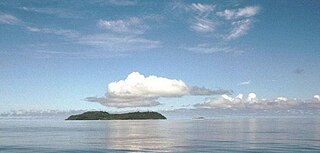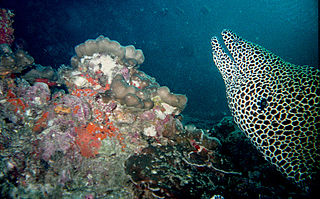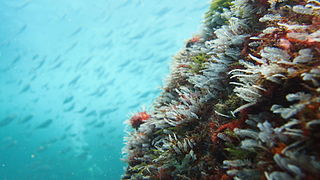
A biome is a large collection of flora and fauna occupying a major habitat.

An ecoregion or ecozone is an ecologically and geographically defined area that is smaller than a bioregion, which in turn is smaller than a biogeographic realm. Ecoregions cover relatively large areas of land or water, and contain characteristic, geographically distinct assemblages of natural communities and species. The biodiversity of flora, fauna and ecosystems that characterise an ecoregion tends to be distinct from that of other ecoregions. In theory, biodiversity or conservation ecoregions are relatively large areas of land or water where the probability of encountering different species and communities at any given point remains relatively constant, within an acceptable range of variation.

A biogeographic realm or ecozone is the broadest biogeographic division of Earth's land surface, based on distributional patterns of terrestrial organisms. They are subdivided into bioregions, which are further subdivided into ecoregions.

The Oceanian realm is one of the World Wildlife Fund (WWF) biogeographic realms, and is unique in not including any continental land mass. It has the smallest land area of any of the WWF realms.

The Banda Sea is one of four seas that surround the Maluku Islands of Indonesia, connected to the Pacific Ocean, but surrounded by hundreds of islands, as well as the Halmahera and Ceram Seas. It is about 1000 km (600 mi) east to west, and about 500 km (300 mi) north to south.
The Philippine archipelago is one of the world's great reservoirs of biodiversity and endemism. The archipelago includes over 7000 islands, and a total land area of 300,780 km².
A marine ecoregion is an ecoregion, or ecological region, of the oceans and seas identified and defined based on biogeographic characteristics.

The Arctic realm is one of the planet's twelve marine realms, as designated by the WWF and Nature Conservancy. It includes the coastal regions and continental shelves of the Arctic Ocean and adjacent seas, including the Arctic Archipelago, Hudson Bay, and the Labrador Sea of northern Canada, the seas surrounding Greenland, the northern and eastern coasts of Iceland, and the eastern Bering Sea.

The Tropical Atlantic realm is one of twelve marine realms that cover the world's coastal seas and continental shelves.

The Western Indo-Pacific is a biogeographic region of the Earth's seas, comprising the tropical waters of the eastern and central Indian Ocean. It is part of the larger Indo-Pacific, which includes the tropical Indian Ocean, the western and central Pacific Ocean, and the seas connecting the two in the general area of Indonesia. The Western Indo-Pacific may be classified as a marine realm, one of the great biogeographic divisions of the world's ocean basins, or as a subrealm of the Indo-Pacific.

The Central Indo-Pacific is a biogeographic region of Earth's seas, comprising the tropical waters of the western Pacific Ocean, the eastern Indian Ocean, and the connecting seas.

The Temperate Northern Pacific is a biogeographic region of the Earth's seas, comprising the temperate waters of the northern Pacific Ocean.
New Guinea, lying within the tropics and with extensive mountain areas, comprises a wide range of ecoregions. These include rainforests, grasslands and mangrove.

Temperate Southern Africa is a biogeographic region of the Earth's seas, comprising the temperate waters of southern Africa, where the Atlantic Ocean and Indian Ocean meet. It includes the coast of South Africa and Namibia, and reaches into southern Angola. It also includes the remote islands of Amsterdam and Saint-Paul, to the east in the southern Indian Ocean.

Temperate South America is a biogeographic region of the Earth's seas, comprising the temperate and subtropical waters of South America, including both the Pacific and Atlantic coasts of the continent and adjacent islands. It also includes the remote Gough Island and Tristan da Cunha in the South Atlantic Ocean.

Temperate Australasia is a biogeographic region of the Earth's seas, comprising the temperate and subtropical waters of Australia and New Zealand, including both the Indian Ocean and Pacific coasts of the continent and adjacent islands.

The Eastern Indo-Pacific is a biogeographic region of the Earth's seas, comprising the tropical waters around island groups in the central Pacific Ocean. It includes most of Polynesia, except for New Zealand and the Kermadec Islands. It also includes the Marshall Islands and Kiribati from Micronesia. It adjoins the Central Indo-Pacific realm to the west, which encompasses Melanesia and the other island groups of Micronesia.
The Magdalena Transition is a marine ecoregion in the eastern Pacific Ocean. It includes the coastal waters along the southwestern Baja California Peninsula, extending from Punta Abreojos in the north to Cabo San Lucas at the peninsula's southern tip.














